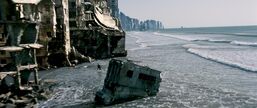talked about British director Christopher Nolan's new work "Inception", the key word naturally revolves around "dream". Movies and dreams have an innate intimacy: movies are called "Daydream", Hollywood is called "Dream Factory", and the neat lineup of actors in "Inception" is called "Dream Team". The film is about Dom Cobb (Leonardo DiCaprio), a thief who can control other people's dreams and sneak into their subconscious to steal economic secrets. High-end and dangerous ideas: An idea is implanted into Saito's rival Robert (Cillian Murphy), the heir of an energy group, to change his mind and dissolve the group. If Saito can monopolize this field, Cobb can also end his desperation. Living in the end of the world, returning to the United States to reunite with a pair of children. Cobb gathers his right men: assistant Arthur (Joseph Gordon Levitt), designer Ariadne (Ellen Page), shapeshifter Eames (Tom Hardy), pharmacist Yusuf (Dilip Law) ), designed a more sophisticated and complex three-layer labyrinth dream structure, and implemented the plan; while Cobb's late wife Mal (Marion Cotillard) appeared in each layer of dreams from time to time to destroy the plan... "Inception" fusion And across genres like action, sci-fi, spy, film noir, and more.
In the first half of the film, the narrative is more sophisticated and interesting, deliberately blurring the boundaries between "reality" and "dream" and even questioning their definitions, occasionally making it difficult for the audience to distinguish what is "illusion" and what is "true", or which layer of "reality" is. ” (or “unrealistic”). The second half is clearer and more organized, emphasizing the rhythmic tension of the transitions between the different layers of dreams and the skilful cross-cutting between the four parallel layers of "reality" (thanks to editor Lee Smith). Parallel cross splicing of multiple time and space, American director DW Griffith's big production "Intolerance" (Intolerance) in 1916 is quite skilled; "Last Minute Rescue" is also there soon after the film was born. The use of these techniques 100 years later does not count as a major innovation and development of film narrative techniques, but with the development of film technology, the audio-visual rhythm has obviously been strengthened. Nolan is more interested in guiding the audience through the process than in setting the suspense (although there is some specious suspense in the film). The mythological and metaphorical implications of the film also increase interpretation possibilities through the setting of character names: Mal means "evil" in French, the "femme fatale" type in the classic "film noir"; Ariadne is Greek The mythological goddess who gives Theseus a spool of thread to help him out of the labyrinth (in the film the character guides the audience, setting her up as a newcomer, explaining to her the rules of the dream game is explaining it to the audience).
The whole plot is a huge hallucination, perspective, time and space change, and layers of mechanisms. This multi-layered meaning of "dream" connects the inside and outside of the film text and the experience of watching the film. The film creation process is similar to the Cobb team's dream-making process, both requiring space and visual imagination. It has gone beyond the imitation of reality and strives to become "pure creation", a virtual reality. Edith Piaf's song "Non, Je Ne Regrette Rien" ("No, I don't regret"), which became the musical motive, has different variations in different dream levels, an example of music intervening in the narrative; Reminder: You too should wake up from this daydream (French actress Marion Cotillard, who played Mal, is best known for her role as Edith Piaf in La Vie Rose, although the director called it "a pure coincidence" ”, inadvertently opening up another layer of self-reflexive cinematic dreams). However, the film's logic about dreams is too precise and mechanical, lacking the ambiguity, surrealism and uncertainty that dreams should have, and there is no obvious difference in vision and performance for each layer of dreams, as if different action films intersect spliced together. This kind of interpretation of "dream" is far from the interpretation of "dream" in Freud's "psychoanalysis" theory.
Nolan's previous works such as "Memento" (2000), "Batman Begins" (2005), "The Prestige" (2006), "The Dark Knight" (2008), etc. , has been concerned about amnesia, insomnia, psychological suggestion and blurred boundaries and mutual conversion between fantasy and reality. "Inception", a super-large dream that spans multiple film genres, is his most splendid and wanton work in visual style, and can be regarded as a summary of the director's career. He has had this idea for ten years, and with the development of film technology, more possibilities are realized. But he prefers to keep the proportion of stunts to a minimum (like the acclaimed Arthur zero-gravity fight in a hotel hallway with a spinning set and dangling actors instead of stunts. Longtime collaborator Wally Pfister is credited with this), to To maintain the "reality" of the dream, the effect of the coexistence of the human body and the environment has a "materiality" that cannot be imitated by special effects. The box office success of "The Dark Knight" earned Nolan a certain degree of creative freedom from Warner Bros., and served as a screenwriter, director, and producer himself. The $160 million investment was shot across four continents and six national cities (London, Paris, Tokyo, Los Angeles, Tangier, Morocco, and Calgary, Canada). Using "dream" as an excuse, the implementation of imagination may be the limit, jumping in time and space, going from heaven to earth, and invincible. And the time in the dream is a relative concept compared to the "real" time, which can be shortened or extended (such as the scene of the car falling into the water).
The concept of entering other people's dreams and directly or indirectly changing the "reality layer" in the movie is not the first of "Inception". There are only two layers, the "reality" layer and the "dream" layer are distinguished by lighting, color tone, wide-angle lens, weird music, etc., and take the opportunity to add action, horror, monsters, erotica and other types of elements to the "dream" layer. "Dreamland" under the commercial package also has the scars of nuclear war and the "small words and great righteousness" to ensure the security of the future world. In contrast, "Inception", it is more of a spectacular and novel scene introduced into the film's traditional themes rather than new creations. The alternate combination of multiple realities and action movie chases and fights is also in the same vein as Hollywood's big productions "The Matrix" and "Avatar". This kind of movie and video game (video game) concept has penetrated into each other on a deeper level (the game borrows the traditional Hollywood narrative logic, and the film also borrows the game rules and audio-visual wonders), but here, as an American film critic said, "It's not. You play it, it plays you". There are several traces of Citizen Kane's influence in the film, such as the "rosebud"-like childhood trauma suggested by the multi-layered mirror image and the objects in the safe at the end (Nolan said in the interview that if he could steal other Director's idea, his first choice is Orson Welles).
The sci-fi nature and imagination of "Inception" is also reminiscent of Kubrick's "2001: A Space Odyssey" and Ridley Scott's "Blade Runner." The snowy mountain scene is reminiscent of "On Her Majesty's Secret Service" (Peter R. Hunt, 1969) - Nolan said he grew up watching "Bond" movies and was deeply influenced by them. The visual design of the film is mostly influenced by European architects and graphic designers, such as German-American architect Mies van der Rohe and Swiss architect Le Corbusier. The streets of Paris, which can be folded and rolled up, seem to pay tribute to the famous work "Ascending and Descending" by Dutch artist MC Escher. Many Western film critics see Nolan as the successor to his British predecessors Hitchcock and Kubrick, and he also inherits their weaknesses: sometimes too precise and logical, such as algebra and geometry, and not enough to enrich the film. of wonderful ambiguity and uncertainty. However, apart from the factors that the world film environment, style, and technology are different from those of decades ago, Nolan does not have many of the advantages of the first two (such as the former's camera narrative skills and the latter's depth of philosophical reflection). Nolan lacks sensibility, but his visual imagination is amazing, and he is also obsessed with narrative structure and sequence. In this electronic age, which pays attention to business vision, operation skills and emotional indifference, Nolan is called "the Spielberg of the digital game age". exact.
"Inception" was very popular in American theaters in the summer, mainly because of "the right proportion of popcorn-depth allocation". The summer schedule is full of non-intellectual entertainment films, and this film combines complex visual spectacle, sensory stimulation with relatively difficult and moderate narrative and imagination, the director's personal fascination with audio-visual spectacle and large-scale popular entertainment. Although the narrative structure is multi-layered, strictly speaking, it is linear and clear, so as not to get lost in the labyrinth of time and space (such as Alan Resnais and David Lynch films). Photography and stunts are quite skillful. Thin characters - criticized by some critics for being more like chess pieces or puppets. The protagonist Dom Cobb's personality has a single plane, and DiCaprio's interpretation is not brilliant; it is the colorful supporting actors who make up for this shortcoming. Good actors save the characters, because they bring in their own personalities and characteristics, such as Gordon Levitt's Arthur is calm and tepid; Tom Hardy has a good sense of humor. What dissatisfied some American film critics (especially some New York newspapers and magazines such as The New Yorker, The New York Times, The Village Voice, etc.) is that the film has more to do with intelligence and logic than emotion, and lacks emotional appeal. Too much audio-visual bombardment without the power to touch people's hearts; form is greater than content, seemingly complex and empty in essence; staying on the surface, without deep meaning, psychological depth and social meaning. Nolan is compared to a technician, mechanical engineer, and game designer, while Inception is seen as a soulless, no-nonsense building constructed according to the "Dream Manual"—a dream. A big movie without characters and emotions, like a big game.
View more about Inception reviews











